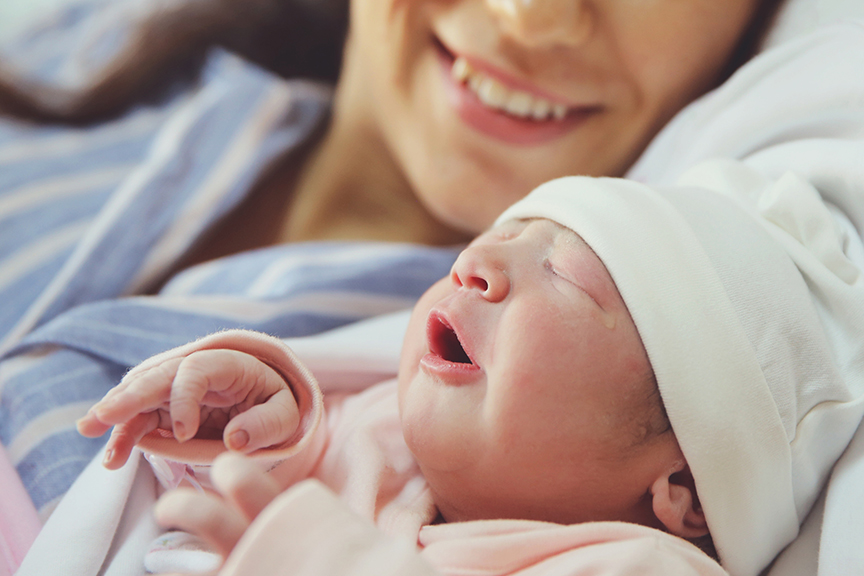
What happens during labor?
Labor is the way a woman’s body prepares to give birth. This involves having contractions, which is when the uterus tightens. Contractions can be painful and make your belly feel hard. During labor, your cervix softens, thins out, and opens up, or “dilates.” As you get closer to giving birth, your baby will move down from the uterus into the vagina. When this happens, it can feel like you are going to have a bowel movement.
Labor usually starts on its own between 37 and 42 weeks of pregnancy. In some cases, doctors will decide to induce labor. This usually involves giving you medicine to soften your cervix and start contractions. To soften the cervix, your doctor might put a thin tube into your vagina and through the cervix. Medicine to start contractions is given into your vein (by IV). Sometimes, labor is induced in other ways.
Doctors only induce labor before 39 weeks if there is a medical reason. Usually, this means a situation where waiting to give birth could be dangerous for you or your baby.
What happens during delivery?
During delivery, the doctor will help you give birth to your baby. When a baby comes out of a woman’s vagina, it’s called a “vaginal delivery.” When a doctor performs surgery to deliver a baby, it’s called a “c-section” or “cesarean delivery.”
During a vaginal delivery, once your cervix has opened all the way, you will work hard to push your baby out. Your doctor will tell you when you can start pushing. In most cases, you can be in whatever position feels comfortable to you. For example, you can lie on your side, sit up, kneel, or squat. Pushing a baby out can take anywhere from minutes to hours. It usually takes longer when it’s a woman’s first baby.
Most mothers can push the baby out without any problems. But sometimes, the doctor will help get the baby out by pulling on a device that can be placed on the baby’s head. If the doctor needs to deliver a baby right away, he or she will do a c-section.
Does childbirth hurt?
Yes, childbirth usually hurts. Pain can come both from contractions and, later, from your vagina stretching as you push your baby out. But the amount of pain is different for each woman. Women choose to manage their pain in different ways. No one way works for everyone. The right decision is the one that is best for you.
Some women choose to have a natural childbirth. This means that they do not use any pain medicines during labor or delivery. Instead, they do other things such as breathing exercises to lessen their pain.
Other women choose to have medicines to lessen the pain of labor and delivery. If you choose to have pain medicine, your doctor or midwife will probably start giving you the medicine during your labor, before delivery.
What if my baby is not in the right position?
Before birth, babies lie in the uterus in different positions. At the end of pregnancy, most babies lie with their head close to the vagina, but some babies lie with their legs, buttocks, or shoulders close to the vagina. Doctors call it breech if a baby’s legs or buttocks are close to the vagina.
If your baby isn’t facing head down, your doctor will talk with you about your options. He or she might be able to turn your baby before you go into labor and deliver him or her vaginally. Or, he or she might suggest that you have a c-section.
What happens after I give birth?
After your baby is born, the doctor will clamp and cut the umbilical cord. Then your baby will be given to you or to a pediatrician if the baby needs to be checked right away. If you and your baby are both healthy, the doctor might wait about a minute before clamping the cord. This allows the baby to receive some of the blood in the placenta. (The placenta is the organ inside the uterus that brings a baby nutrients and oxygen and carries away waste.)
Next, the placenta also needs to come out of the uterus. Usually, the placenta comes out naturally within 30 minutes of the baby’s birth, but sometimes the doctor has to help remove it.
After the placenta is out of your uterus, the doctor will examine your vagina. If your skin tore during birth, you might need some stitches.
What happens to my baby after birth?
After birth, the doctor, nurse, or pediatrician will do a quick exam to check your baby’s body and general health. Part of this exam is called an Apgar test. It checks your baby’s heart rate, breathing, movement, muscles, and skin color. Your baby will get Apgar tests at one minute and five minutes after birth.
Soon after birth, you will be able to hold your baby. You can even breastfeed him or her, if you choose to breastfeed.
Your baby will receive several treatments soon after birth. These include eye drops or an eye ointment to prevent an eye infection and a dose of vitamin K to prevent abnormal bleeding.
Before your baby leaves the hospital, he or she will also have:
- A detailed physical exam
- A blood test (done by a heel prick) to check for different serious diseases that babies can be born with. (For more information on this testing, ask your doctor or nurse.)
- A hearing test
- A dose of the hepatitis B vaccine. Vaccines can prevent certain serious or deadly infections. Hepatitis B is a serious liver infection.
When should I call the doctor after a vaginal delivery?
After you leave the hospital, call your doctor or nurse if you:
- Bleed a lot from your vagina – It is normal to have some vaginal bleeding for a few weeks after delivery. But let your doctor or nurse know if you are having large blood clots or your bleeding increases.
- Feel dizzy or faint
- Get a fever
- Vomit
- Have new belly pain
- Have a severe headache or problems with your vision
- Feel sad or helpless
This topic retrieved from UpToDate on: Nov 21, 2018.

